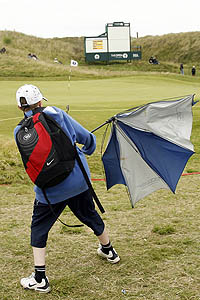 It's only Tuesday and Mt. St. 17th-Green-At-Birkdale is about to erupt. Just imagine the possibilities when the tournament starts and the wind blows!
It's only Tuesday and Mt. St. 17th-Green-At-Birkdale is about to erupt. Just imagine the possibilities when the tournament starts and the wind blows!
Before we get to the articles and after a lengthy search (because Lord knows we need more photos of guys hitting out a bunker), I finally found a shot of the 17th green in Golfweek's roster of images from Tuesday (the volume lowering tool is in the lower right). 
No. 17 at Birkdale, courtesy of Golfweek (click to enlarge)
....we have several fine stories full of all sorts of rich, compelling and incriminating detail. Here's John Huggan quoting Geoff Ogilvy:
"If Birkdale were a one-hole course this green would be out of character with the rest of the course. It's out of character with the land; it's out of character with the hole.
"You can see from 250 yards away that something has gone wrong. Sadly, it could be a decisive factor in who wins the championship. You could get some really crazy putts going on there. Funky bounces, too. A guy could hit a great shot in and see his ball take a really weird kick left or right. It's fine to have a tough green, but it has to look right. It just doesn't fit the spot that it is in, or the hole that it is on, or the rest of the course."
But other than that...Huggan also shares this from
Robert Allenby:
"The problem is that whenever they try to change these great courses, they always stuff it up by doing something like that. You can argue they do these things because of how far the ball goes these days, but this has nothing to do with that. It's a mess that has obviously been made by someone who doesn't know how to design golf courses. He's built a green that isn't even close to the other 17. It's just stupid. If they revisit it after the championship I hope they use someone else."
So Huggan went to the vision behind the green and well, Martin Hawtree probably didn't help matters with either the players or his architectural Godfather Peter Dawson:
"In previous Birkdale Opens the 17th had been the easiest or one of the easiest holes," said Hawtree, who will lay out Donald Trump's proposed new course near Aberdeen should the present public inquiry into the project give the go-ahead. "So it needed stiffening.
I will spare you a Viagra joke here. Continue...
We moved the green back to the point where the front of the new green is where the back of the old one was. Then we added another tier. In my original concept of the hole there was nothing at the back of the green. The two big dunes there create an amphitheatre effect so I felt that the green should run on into a hollow at the rear. I wasn't allowed to do that though; the R&A wanted spectator mounds. So now the green forms too much of a bowl shape.
"I'm taken aback by the depth of the reaction. It was a weak hole and demanded something be done. I have heard that the club want to redo the green complex after the Open. I'd be more than happy to move the mounds at the back and create my original idea."
Just guessing by the comments, the lack of a rear hollow seems to be the least of the problems here.
Mike Aitken in the Scotsman talks to the other culprit behind this mess, R&A Executive Secretary and in-house architect Peter Dawson:
"Well, this has caused a little bit of controversy," he said. "And, as a result of that, I'd like to say a few things about it. It's a par 5, so it's not as if we're expecting the green to be hit at with long irons. It's a green the pros are accustomed to facing on many of the courses they play.
"If you look at Augusta, there are probably 18 more sporty greens than this one."
Lee Westwood echoes some of his fellow competitors' concerns about the 17th green, which is described in the official course guide as a "tiny, two-tier target with extreme undulations".
"I think everybody has accepted that something has gone wrong with it," said Westwood. "It's just out of character with the rest of the course, (let's] basically leave it at that.
"It's not to the standard of the rest of the greens. The rest of them are brilliant."
Bloomberg's Michael Buteau also looked at the 17th green and shares this from Steve Stricker:
"You wish they'd just leave them alone because they're good for a reason,'' said Steve Stricker, the No. 8-ranked player. ``They've withstood the test of time, equipment and everything else.''
Buteau also shares the same excuse reply from Dawson and I thought by printing it again it would make sense, but it still does not.
Dawson said organizers weren't expecting many golfers to attempt to land their second shots on the putting surface.
``It's not as if we're expecting the green to be hit at with long irons,'' he said. ``We're aware that it's a green that could get away from us if we're not careful. We'll have to see how it goes.''
So if the green could be "hit at" with long irons, that would make it better or even worse? I really need Peter's book of design guidelines to help here, because I think he's really onto something.
Competitors such as Stricker said they wish they could roll back the clock.
James Corrigan files an excellent look at the controversy, also ends the piece with his breakdown of the "12 to follow" at Birkdale. But first, his take on the 17th green, using overheard player comments:
One labelled it "a sloping mess of mounds" while another concluded that it looks as if it's "contracted a severe case of mumps". Even those not totally anti the mogul run have agreed that it is not in keeping with the other greens that have help confirmed Birkdale's reputation as the finest and fairest course in England. In Westwood's opinion they should unload the shovels and start again. That is exactly what the members are planning. But perhaps not before next Monday.
Jack Nicklaus played here in April and was aghast. "You've got one of the greatest golf courses in the world, and they changed 16 holes because of a stupid golf ball," said the 18-time major champion. "That is just ridiculous."
Okay, how did I miss one of the best quotes ever? Where did he say this? Please readers, guide me!
Nicklaus was speaking for an ever-growing number who believe that the authorities should have placed limits on how far the modern golf ball travels. They failed to act, however, and now the only defence they appear to have to protect the dignity of old courses is either course lengthening or course toughening. Or in the case of the 17th, both. On occasions, the powers that be have gone overboard like at Shinnecock Hills at the US Open in 2004 when the greens were quick to the point of unplayable. The R&A is blessedly not the United States Golf Association and is not about to let their stubborn mistakes re-occur here. But they have created an eyesore. Slam, bam in the middle of golfing beauty.
I'm not sure about the USGA reference, since they didn't create the 7th green at Shinnecock. It's one thing go blunder a set-up, because with a little bad luck, bad planning and a steep green, anything can happen. But to make a mess of things before you even set the course up takes a special talent that takes things to an entirely different level.
This is yet another reminder as to why governing bodies should not design golf courses, particularly when it's in response to their own (continued) inability to regulate equipment.






















